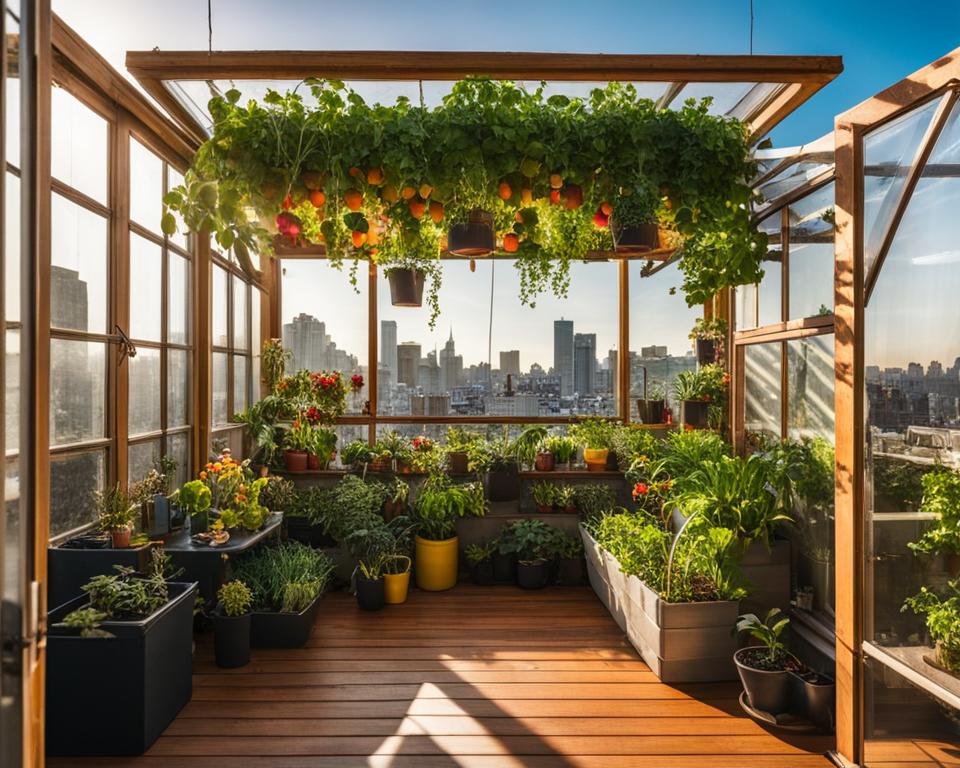Looking to bring some greenery into your small space? Urban gardening is the perfect solution! With a balcony greenhouse DIY project, you can transform your tiny outdoor oasis into a vibrant and lush garden. Whether you have a spacious balcony or a cozy rooftop, this article will provide you with all the tips and ideas you need to create a thriving urban garden.
Small space gardening doesn’t have to be a challenge. By utilizing clever techniques and innovative ideas, you can make the most of your limited area and grow your own food right in the heart of the city. From community gardens to rooftop havens, we’ve got you covered with a wide range of options.
Stay tuned for the upcoming sections where we’ll explore how to create a community garden, design an urban rooftop garden, turn your balcony into a green paradise, opt for a container garden, build your own mini greenhouse, grow a vertical garden, arrange a rain gutter garden, and craft a DIY pallet planter. Let’s get started on revamping your space with urban gardening!
Create a Community Garden
If you’re looking to immerse yourself in urban gardening while fostering a sense of community, creating a community garden is the perfect solution. Community gardens are shared outdoor spaces where individuals come together to plant and maintain vegetables, flowers, and herbs. Not only do these gardens provide fresh, locally grown food, but they also create a space where neighbors can gather, learn from each other, and foster a strong sense of community.
One of the main advantages of community gardens is their ability to address food insecurity in urban areas, commonly known as “food deserts.” These are areas where fresh and affordable food is scarce. By growing their own produce in community gardens, residents can have access to nutritious fruits and vegetables, improving their overall health and well-being.
Additionally, community gardens promote teamwork and collaboration. Gardeners share responsibilities, such as watering, weeding, and harvesting, which not only lightens the workload but also encourages social interaction and the exchange of gardening knowledge and tips. It’s a wonderful opportunity to learn from experienced gardeners and to educate others about sustainable gardening practices.
Benefits of Community Gardens:
- Provides fresh, locally grown food in food deserts
- Fosters a sense of community and social interaction
- Encourages teamwork and collaboration
- Promotes sustainable gardening practices and knowledge exchange
Creating a community garden may require some initial planning and organizing. Start by reaching out to local community centers, schools, or neighborhood associations to gauge interest and find potential partners. It’s important to secure a suitable location for the garden, ensuring access to sunlight and water.
Once you have a group of enthusiastic individuals, establish guidelines and rules for the community garden, including membership fees, planting schedules, and sharing responsibilities. Consider organizing regular workshops or gardening classes to provide education and training to both new and experienced gardeners.
In conclusion, community gardens are not only a means to grow fresh food but also a way to cultivate a stronger sense of community. Through collaboration and knowledge sharing, these gardens have the power to transform urban spaces into vibrant green oases that benefit both individuals and neighborhoods as a whole.
Design an Urban Rooftop Garden
When it comes to urban gardening, one of the most creative and space-efficient options is designing a rooftop garden. Rooftop gardens allow you to utilize unused spaces in the city and create a beautiful green oasis right above your head. However, before you start planning your rooftop garden, it’s important to consider a few key factors.
Choosing the Right Lightweight Materials
Since rooftop gardens are situated above the ground, it’s crucial to check any regulations or weight limits with your landlord or co-op board. Using lightweight materials for your garden will help ensure that the structure can support the garden without causing any structural issues. Opt for wooden or fiberglass planters that are not only durable but also easy to move around if needed.
Protecting Against Wind with Trellises
Due to their elevated location, rooftop gardens may be exposed to higher wind speeds. To protect your plants from wind damage, consider installing trellises or other support structures. These will not only provide stability but also help climbers and vine plants grow vertically, maximizing your garden space. Additionally, using trellises can create a visually appealing and aesthetically pleasing vertical garden.
Creating a Visually Engaging Rooftop Garden
When designing your rooftop garden, aim for a visually engaging and well-organized layout. Consider incorporating a variety of plants such as ornamentals, vegetables, and herbs to add color and texture to your rooftop space. Utilize different plant heights, vibrant blooms, and a mix of annuals and perennials to create a dynamic and ever-changing urban oasis.
Summary:
Designing an urban rooftop garden is a fantastic way to transform unused space into a flourishing green haven. Before starting your rooftop garden project, ensure that you have checked any regulations or weight limits and use lightweight materials like wooden or fiberglass planters. Implement trellises to protect your plants from wind damage and create a visually engaging layout by incorporating a variety of plants with different heights and colors. So, get ready to enjoy the tranquility of nature right on your rooftop!
| Benefits of a Rooftop Garden | Challenges of a Rooftop Garden |
|---|---|
| 1. Utilizes unused space | 1. Weight restrictions and structural considerations |
| 2. Provides fresh air and improved air quality | 2. Potential for wind damage to plants |
| 3. Enhances the aesthetics of your building | 3. Limited growing depth for certain plants |
| 4. Reduces urban heat island effect | 4. Limited accessibility for maintenance |
| 5. Offers a peaceful and serene environment | 5. Additional considerations for water drainage and irrigation |
Turn Your Balcony into a Garden
If you have a balcony, you have a perfect opportunity to create a thriving garden in a small space. With a little planning and creativity, you can transform your balcony into a green oasis that provides beauty and nourishment. Here are some balcony gardening ideas to get you started:
- Utilize container pots: Use a variety of pots in different sizes to grow a variety of plants. Choose lightweight pots that won’t put too much weight on your balcony railing or floor. Arrange them strategically to create a visually appealing display.
- Hanging or vertical planters: Maximize your space by hanging planters from the ceiling or attaching them to the walls. Vertical gardening allows you to grow more plants in a smaller area.
- Pallet walls: Repurpose wooden pallets to create a vertical garden wall. Attach planters to the pallets and fill them with your favorite plants. This not only adds greenery to your balcony but also acts as a privacy screen.
When selecting plants for your balcony garden, consider both annual and perennial plants. Annuals provide seasonal color and can be easily replaced, while perennials will come back year after year. Additionally, growing vegetables like tomatoes, lettuce, and cucumbers can provide you with fresh produce right outside your door.
It’s important to remember to use saucers under your pots to prevent water from draining onto neighboring balconies. This will help you maintain good relations with your neighbors and keep your balcony clean and tidy.
“I love spending time on my balcony surrounded by plants. It’s like having my own little sanctuary in the midst of the city.” – Sarah, balcony gardener
With a little creativity and some green thumbs, you can turn your balcony into a beautiful garden retreat. Whether you prefer flowers, herbs, or vegetables, there are endless possibilities for creating a balcony garden that suits your style and tastes.
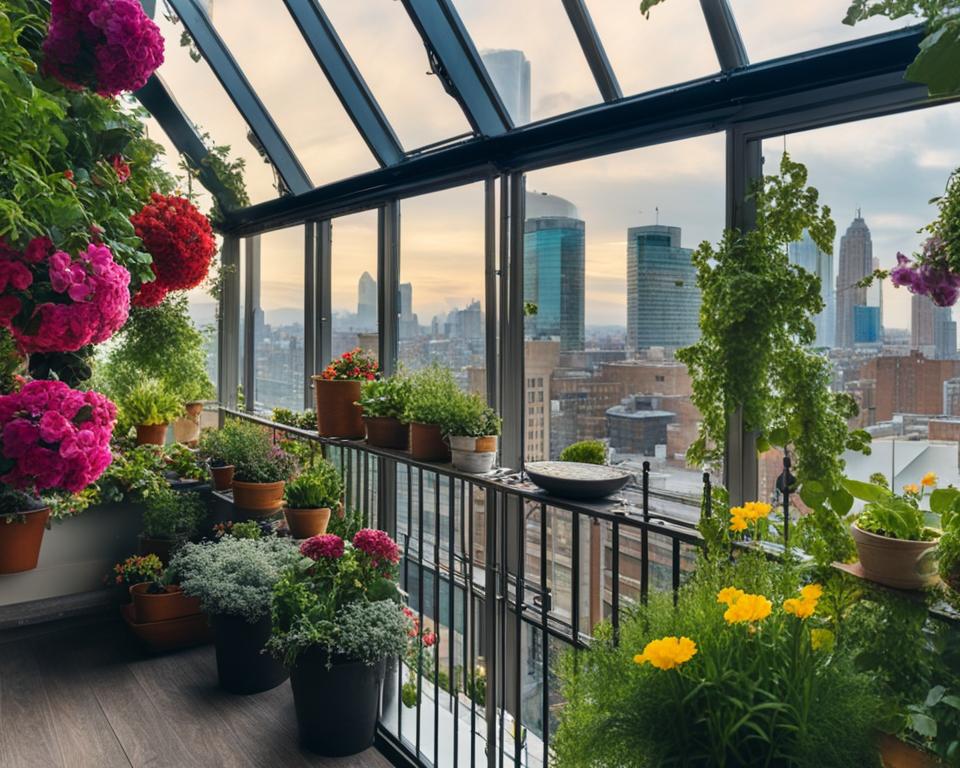
Opt for a Container Garden
When it comes to urban gardening in small spaces like balconies or patios, a container garden is a perfect solution. With a little creativity and some basic materials, you can create a thriving garden right in the comfort of your own home. Here are some balcony gardening hacks to help you create a beautiful and functional container garden.
Choosing the Right Containers
One of the keys to a successful container garden is choosing the right containers. Consider using a variety of pots, barrels, or buckets with adequate drainage. This will ensure that your plants have enough space to grow and that excess water can easily drain away. Additionally, using lightweight materials like plastic or fiberglass can make it easier to move your containers around if needed.
Double-potting your plants on hot days can also provide them with extra insulation and protect their roots from overheating. Simply place a smaller pot inside a larger one, and fill the space between them with insulation material like sphagnum moss or perlite.
Creative Display Ideas
Creating a unique and visually appealing container garden is all about thinking outside the box. Instead of just placing your pots on the ground, consider using wooden boards and rope to create hanging displays. This not only adds a touch of charm to your garden but also maximizes vertical space.
Another idea is to use shelves or racks to create a multi-tiered garden. This allows you to grow a variety of plants in a small amount of space. You can also use vertical planters, trellises, or even repurpose old items like shoe organizers or pallets to create unique and functional displays for your plants.
Essential Care Tips
Once you’ve set up your container garden, it’s important to provide proper care to ensure the health and growth of your plants. Here are some essential care tips for balcony gardening:
- Water your plants regularly, but be careful not to overwater. Containers can dry out quickly, especially in hot weather.
- Use a quality potting mix that is well-draining and contains nutrients to support plant growth.
- Fertilize your plants regularly to provide them with the necessary nutrients. Choose a fertilizer specifically formulated for container plants.
- Monitor your plants for any signs of pests or diseases and take appropriate action to prevent damage.
- Prune and trim your plants as needed to maintain their shape and promote healthy growth.
By following these tips and getting creative with your container garden, you can enjoy the benefits of urban gardening even in the smallest of spaces.
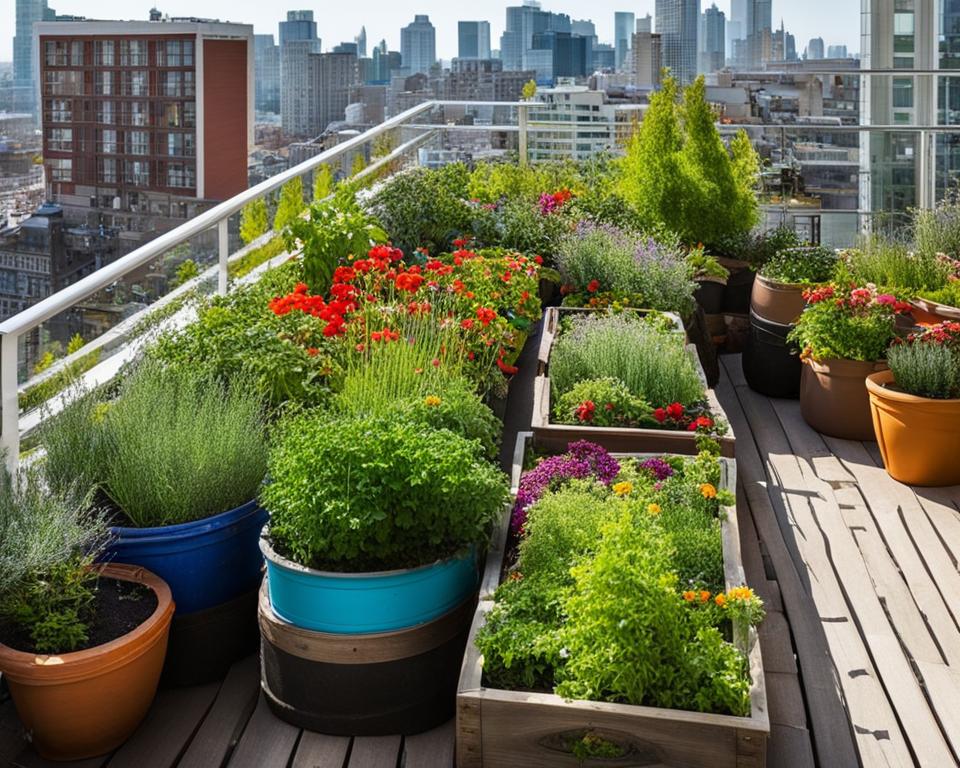
| Advantages of Container Gardening | Disadvantages of Container Gardening |
|---|---|
| Allows gardening in limited spaces | Regular watering is essential |
| Easy to move and rearrange plants | Plants may become root-bound if not repotted regularly |
| Prevents weeds and pests from spreading easily | Some plants may outgrow their containers and need to be replanted |
| Can be a cost-effective option for gardening | Susceptible to temperature fluctuations |
Build Your Own Mini Greenhouse
Creating a mini greenhouse is an excellent option for urban gardeners who want to extend their growing season and protect delicate plants from harsh weather conditions. With a few affordable materials and a little DIY know-how, you can build your own mini greenhouse right in the comfort of your own small balcony or rooftop garden.
To get started, consider using PVC pipes or metal hoops to create the frame of your mini greenhouse. These materials are lightweight, easy to work with, and can be shaped into the desired structure. Attach the pipes or hoops to sturdy wooden or metal stakes that can be securely anchored into the ground or pots. This will provide the stability needed to withstand windy conditions.
For the covering of your mini greenhouse, you have several options. One option is to use clear plastic sheeting, which is readily available and cost-effective. Another option is to repurpose old windows or glass panels, which not only provide excellent insulation but also add a touch of elegance to your urban garden. Secure the covering to the frame using clips or adhesive strips, ensuring that it is tightly sealed to retain heat and moisture.
Once your mini greenhouse is constructed, it’s important to create a suitable environment for your plants. Place containers or raised beds inside the greenhouse and fill them with nutrient-rich soil. Consider adding a layer of mulch to retain moisture and improve soil quality. Monitor temperature and humidity levels regularly, and adjust ventilation as needed to prevent overheating.
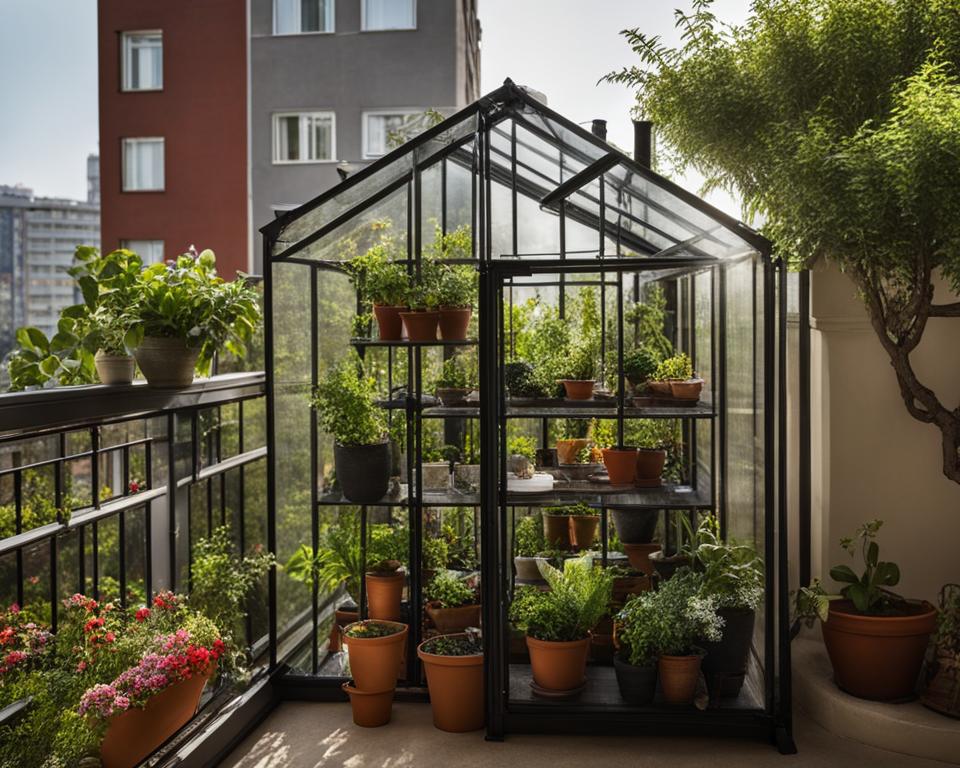
Benefits of a Mini Greenhouse
A mini greenhouse offers several benefits for urban gardeners. Firstly, it provides a controlled environment that extends the growing season, allowing you to start seeds earlier and harvest later into the year. This is particularly advantageous for those living in colder climates where the growing season is limited.
Secondly, a mini greenhouse protects your plants from extreme weather conditions such as frost, wind, and heavy rain. It acts as a shield, ensuring that your plants receive adequate warmth, sunlight, and moisture for optimal growth.
Lastly, a mini greenhouse creates a microclimate that allows you to grow a wider range of plants. With the ability to control temperature, humidity, and ventilation, you can cultivate tropical or delicate plants that would otherwise struggle to survive in your urban environment.
| Benefits of a Mini Greenhouse | Advantages |
|---|---|
| Extended growing season | Start seeds earlier, harvest later |
| Protection from extreme weather | Shield from frost, wind, and heavy rain |
| Ability to grow a wider range of plants | Cultivate tropical or delicate plants |
By building your own mini greenhouse, you can create a thriving oasis in the midst of an urban landscape. Whether you’re growing flowers, vegetables, or herbs, this DIY project will not only enhance the beauty of your balcony or rooftop garden but also provide you with an abundant and sustainable source of fresh produce throughout the year.
Grow a Vertical Garden
Creating a vertical garden is an innovative and space-efficient way to bring greenery into small urban spaces. Whether you have a tiny balcony, a narrow alleyway, or even just a blank wall, vertical gardening can transform any area into a lush oasis. By utilizing vertical surfaces, you can maximize your gardening space and create a visually appealing environment.
One popular technique for vertical gardening is using vines or vertical planters to cover walls or fences. These plants not only add beauty and texture to your space but also provide privacy and shade. Ready-to-assemble kits are available for those looking for a quick and convenient solution, while DIY trellises allow for a more personalized touch. Additionally, bookcases and standing shelves can be repurposed to create vertical gardens, providing a unique and functional display for your plants.
When choosing plants for your vertical garden, consider their growth habits and light requirements. Opt for trailing or climbing plants that will naturally flow downward or attach themselves to trellises. Some popular choices include ivy, ferns, succulents, and herbs like mint or thyme. Ensure that your plants receive adequate sunlight by placing your vertical garden in a well-lit area, either near a window or in a spot that receives direct sunlight for at least a few hours each day.
Vertical gardening not only allows you to grow a variety of plants in small spaces, but it also has numerous benefits for the environment and your well-being. By adding greenery to urban areas, you can help combat air pollution, reduce the urban heat island effect, and improve overall air quality. Furthermore, gardening has been shown to reduce stress levels and improve mental health, providing a calming and therapeutic outlet for city dwellers.
Benefits of Vertical Gardening:
- Maximizes gardening space in small urban areas
- Creates privacy and shade with vines or vertical planters
- Offers a variety of plants to choose from, including trailing and climbing species
- Improves air quality and reduces pollution in urban environments
- Provides a calming and therapeutic outlet for city dwellers
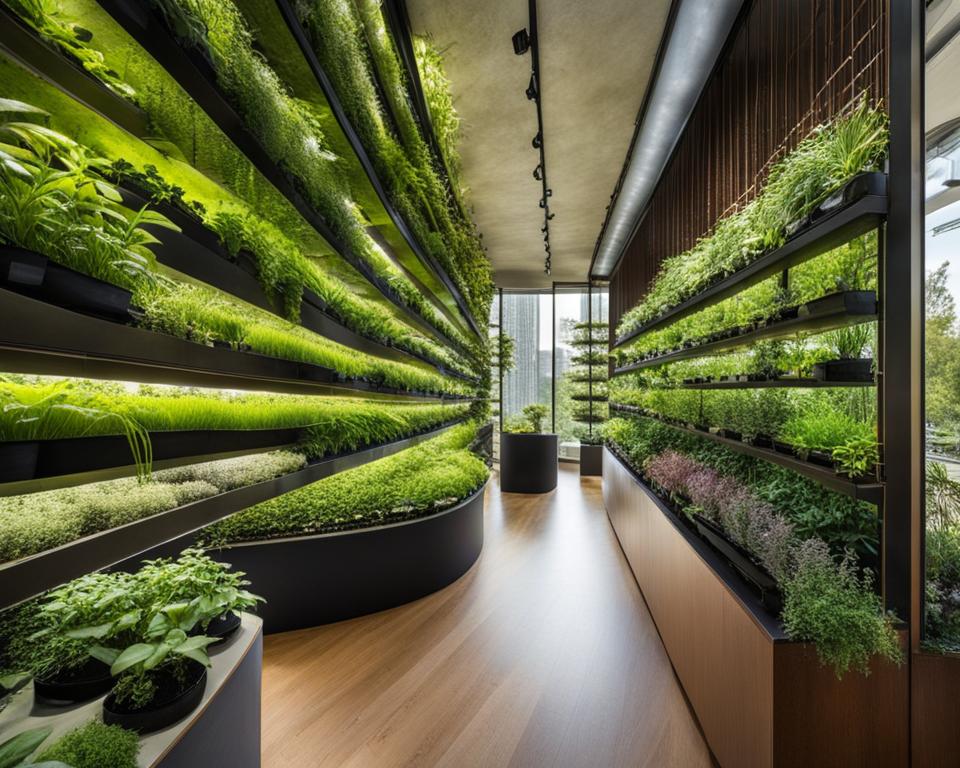
Tips for Maintaining a Vertical Garden:
- Regularly water your plants, ensuring that the water reaches all levels of your vertical garden
- Monitor the sunlight levels and adjust the positioning of your vertical garden accordingly
- Trim and prune your plants to maintain their shape and prevent overcrowding
- Use a quality potting mix and provide adequate nutrients for healthy plant growth
- Inspect your vertical garden for pests and disease regularly, taking appropriate measures to prevent or treat issues
Arrange a Rain Gutter Garden
Looking for a creative and budget-friendly way to have a productive urban garden? Consider arranging a rain gutter garden. This clever technique is perfect for limited rental spaces or future moves, as rain gutters are portable and inexpensive alternatives to larger garden pots.
To set up a rain gutter garden, start by attaching rain gutters to fences or railings in a sunny location. This will provide the plants with the necessary sunlight to thrive. Make sure to drill small holes in the bottom of the rain gutters to allow for proper drainage. Fill the gutters with nutrient-rich soil and plant your favorite herbs, vegetables, or flowers.
One of the advantages of a rain gutter garden is its versatility. You can easily customize the length and depth of the gutters to fit your available space. Additionally, you can plant a variety of plants, creating a vibrant and diverse garden. To make the most of your rain gutter garden, consider using trellises or stakes for climbing plants like tomatoes or cucumbers. This will help optimize vertical space and maximize your harvest.
With a rain gutter garden, you can enjoy fresh produce and beautiful blooms, even in a small urban setting. It’s a fun and practical way to make the most of limited gardening space while adding a touch of greenery to your surroundings.
| Advantages of a Rain Gutter Garden | Considerations for a Rain Gutter Garden |
|---|---|
|
|
Craft a DIY Pallet Planter
Looking for a creative and space-saving way to grow your urban garden? Why not try crafting a DIY pallet planter? These versatile planters are not only easy to build but also perfect for balconies and small spaces. Let me show you how!
To begin, find a sturdy wooden pallet that’s in good condition. Ensure that it’s untreated or has been properly cleaned and sanded. Once you have your pallet, you can start the transformation process.
First, determine whether you want to mount the pallet onto a wall or simply lean it against one. Both options work well depending on your available space and preference. Next, line the back of the pallet with landscape fabric or a weed barrier to prevent soil from falling out. Then, fill the compartments with potting soil, leaving a sufficient amount of space for the plants to grow.
Now comes the exciting part – choosing your plants! Pallet planters are ideal for growing succulents, flowers, herbs, or even leafy greens like lettuce and spinach. Plant your chosen greenery in the gaps between the slats, making sure to provide enough room for each plant to thrive.
Once your plants are in place, water them thoroughly. Be mindful of drainage since pallet planters may not have built-in drainage holes. To avoid overwatering, use a spray bottle or watering can with a narrow spout to target the soil around each plant. Regularly check the moisture levels and adjust your watering accordingly.
With your DIY pallet planter complete, you now have a beautiful balcony greenhouse that adds charm and greenery to your urban space. Don’t forget to position your planter in an area that receives adequate sunlight and ensure proper maintenance by trimming, watering, and fertilizing your plants as needed. Enjoy your thriving urban garden!
FAQ
Can I start an urban garden on my balcony?
Absolutely! Whether you have a small balcony or a rooftop green space, you can create a beautiful urban garden and grow your own food in the city. Check out our section on “Turn Your Balcony into a Garden” for more tips and ideas.
Are community gardens a good option for urban gardening?
Yes! Community gardens are a great way to plant vegetables, flowers, and herbs in a shared outdoor space. They not only provide fresh food to “food deserts” but also foster a sense of community and allow for teamwork in maintaining the garden. Learn more in our section on “Create a Community Garden.”
Can I have a rooftop garden in the city?
Definitely! Rooftop gardens are a fantastic way to utilize unused spaces in the city. Before starting a rooftop garden, it’s important to check any regulations or weight limits with your landlord or co-op board. Lightweight materials like wooden or fiberglass planters, as well as trellises for protection against wind, are recommended. Check out our section on “Design an Urban Rooftop Garden” for more details.
What plants can I grow on my balcony?
You can grow a wide variety of plants on your balcony, including annual and perennial flowers, as well as vegetables like tomatoes, lettuce, and cucumbers. Our section on “Turn Your Balcony into a Garden” offers more balcony gardening ideas and tips.
How can I create a container garden in a small space?
Small spaces like patios, balconies, and rooftops are perfect for container gardens. Use a variety of pots, barrels, or buckets with adequate drainage. Double-pot plants on hot days and water them regularly. Hanging displays with wooden boards and rope can also create a unique container garden. Find more container gardening hacks in our section on “Opt for a Container Garden.”
Can I have a mini greenhouse on my balcony?
Absolutely! If you have limited space, you can create your own mini greenhouse using affordable materials. Mini greenhouses are perfect for small balconies, apartment rooftops, and patios. They provide a controlled environment for year-round gardening and can add a touch of nature to your living space. Check out our section on “Build Your Own Mini Greenhouse” for more details.
How can I maximize green space in small areas?
Vertical gardening is an excellent way to maximize green space in small areas. Use vines or vertical planters to create a beautiful and affordable green space at home. Ready-to-assemble kits or DIY trellises can help plants stay upright. Bookcases and standing shelves can also be used to utilize vertical space. Learn more in our section on “Grow a Vertical Garden.”
How can I garden in limited rental spaces?
If you have limited rental space or are planning to move in the future, creating a rain gutter garden is a creative solution. Rain gutters are cost-effective and portable alternatives to larger garden pots. They can be attached to fences or railings, serving as productive urban gardens. Rain gutters can also be more budget-friendly than larger gardening supplies. Find out more in our section on “Arrange a Rain Gutter Garden.”
How can I create a DIY planter with pallets?
If you’re looking for a functional and space-saving urban garden solution, you can create an easy pallet wall planter. These planters can be mounted or leaned against a wall and are perfect for succulents, flowers, lettuce, and spinach. Pallet wall planters can also be easily moved between different garden spaces or gardens. Check out our section on “Craft a DIY Pallet Planter” for step-by-step instructions.

